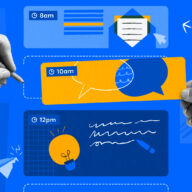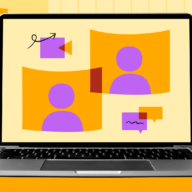5-second summary
- Team meeting agendas help you prioritize important topics and keep things running smoothly and efficiently, so your team walks away from the meeting feeling motivated and aligned.
- All agendas are not created equal; read our tips to learn what to include on every agenda, and how to tailor your agenda depending on the goals of your meeting.
- Templates are a helpful jumping-off point, and can be tailored to meet the needs of your particular meeting.
Imagine you’re knee-deep in work, laser-focused, and ready to tackle the next task on your lengthy list. Nothing can stand in your way…except for the meeting you have in 10 minutes. Now imagine that you come out of that meeting inspired and motivated – exhilarated, even. And despite that dreaded context-switching, you’re able to pick up right where you left off with even more gas in the tank. This is how productive and effective meetings should make you feel. But how do you get there?
Your secret weapon might just be a team meeting agenda. Too often relegated to an afterthought, this handy tool can go a long way to help you run more effective in-person or virtual meetings. It helps with managing time, setting expectations, and staying on the task at hand. Agendas ensure that you have a clear purpose and that you can achieve the goals you set, whether you’re plotting your quarterly budget or creating a project timeline – real, shareable results. Team meeting agendas also help you prioritize the things you want to talk about, so you can guide your team through the most important topics of the week.
Leading productive, fruitful meetings doesn’t always come naturally – and that’s okay. Follow these helpful tips for creating an effective team meeting agenda, including a few free templates to get you started and a video with tips on how Atlassian approaches meeting agendas, taken from Atlassian University’s course How to Run Effective Meetings.
What is a team meeting agenda?
A team meeting agenda is an organized and scheduled list of topics and action items that you plan to discuss with your team during a meeting. It’s there to help you prioritize the most important topics and keep things running smoothly and efficiently so your team walks away from the meeting feeling motivated and aligned. But it’s not enough to jot down a simple list of topics and put a time stamp next to each one; it actually takes a fair amount of thought and effort to organize an effective team meeting agenda.
5 tips for creating an effective team meeting agenda
The most effective team meeting agendas are well-planned, clear, and concise. Here, it really helps to take a step back and put yourself in your team’s shoes. Be sure to consider your audience and what they already know; the purpose of your meeting (are you trying to solve a problem, brainstorm ideas, or make a decision; and how you can make your meeting as engaging and memorable as possible?
After skimming the agenda items, all team members should understand the purpose of the meeting and their roles within it, as well as anything they need to prepare for like questions about a certain project or deadline. This kind of preparation eliminates distractions and keeps the momentum going, leading to a more productive meeting. Here are five ways to create an effective team meeting agenda.
- Tailor your agenda to each meeting. Not all meetings are created equal, and not all agendas should be either. Maybe your weekly team meeting agenda needs a space for wins and shoutouts, but your workshop meeting agenda doesn’t. Because there are many types of meetings, do your best to format your agenda in a way that’s appropriate for your meeting and your team.
- Prioritize your agenda items. They’re the meat of your entire meeting – the reason(s) you’ve decided it was worthwhile to pull everyone away from their work and discuss each topic. That’s why it’s absolutely necessary to prioritize each item from highest priority to lowest priority, with the understanding that you’ll push the lowest-priority items to the next meeting if you run out of time.
- Include an icebreaker or other team-building activity. Icebreakers set a more casual tone (if that’s what you’re going for), and serve as a way to engage each person on the team. But keep in mind the size of your team and the length of your meeting. A complex icebreaker with 20 participants could take up your whole meeting.
- Hold enough time for questions and discussion. A well-planned meeting holds more than a measly 60 seconds for questions at the end. Reserve enough time to discuss the items on your agenda and encourage participation. Instead of asking, “Do you have any questions?” Try rephrasing it as “What questions do you have?” It’s a lot easier to shake your head “no” and get on with your day rather than thinking about questions for the agenda items. This could also spark healthy debate and spars.
- End on a positive note. Saving a few minutes to give team members some kudos will leave them feeling valued and motivated – when’s the last time you got an appreciative shoutout and did less work afterward? Whether it’s calling out people individually or thanking everyone as a group, your team will see that their hard work doesn’t go unnoticed.
On a more granular level, here are some characteristics at the core of most or all team meeting agendas.
What should all team meeting agendas include?
Every team meeting agenda should include the following basic elements to keep everyone in the loop:
- Date, time, and location: These details are especially important for dispersed teams. Be mindful of where everyone is and specify which time zone you’re in. As for the location, these days it might be a Zoom link or another chat channel instead of a physical location, so don’t forget to include that as well.
- Objective and goals: Use this as your North Star. Ask yourself, “What type of meeting is this? What am I trying to get out of it?” Be straightforward with everyone else about it so everyone’s on the same page and stays focused on the task at hand.
- Facilitator and attendees: You don’t necessarily have to take attendance, but keeping track of who’s running the show can orient team members about who to notify in case they can’t make it to the meeting or if they have something to add to the agenda.
- Agenda items: The purpose of agenda items is to make it crystal clear to the team what topics you’ll be discussing, what you want to accomplish within that item, and any action that needs to be taken. Keep it brief and avoid using jargon so everyone has a crystal-clear understanding of what’s to come.
- Time for each topic: Indicating an estimated time for each agenda item is crucial to keeping your meeting on track and on pace.
- Team check-in: Whether or not you do an icebreaker, find time to check in with your team members and their well-being. It’s important to show compassion and make sure they know you also care about factors that might be affecting them outside of work. Check-ins also ease your team into the meeting before diving right into business.
It’s also worth noting that agendas need to be circulated to all participants at least a day before the meeting. Doing so ensures that your team has had a chance to review what projects and assignments will be covered so that they come prepared for discussion. You might also welcome some feedback from your team in case you missed a thing or two.
Atlassian’s approach to team meeting agendas
Curious about how we approach meeting agendas at Atlassian? Check out this clip from Mark Cruth, Atlassian’s resident Modern Work expert and evangelist. Focused on practice over theory, Mark spends his days coaching both Atlassian and customer teams on new ways of working.
For more practical tips, enroll in the How to Run Effective Meetings course from Atlassian University – it’s completely free.
Team meeting agenda templates to get you started
You might be wondering whether it’s worth your time to create an agenda. Although it can be a lot of work upfront, the amount of time you put into making a clear agenda can be compensated for by the efficiency of your now-wildly-productive meeting.
There are tons of free templates to choose from online – don’t hesitate to tailor them to your meeting’s particular needs. To start, check out our top team meeting agenda Confluence templates (downloadable with a free account) and explore how you can make each one your own.






















